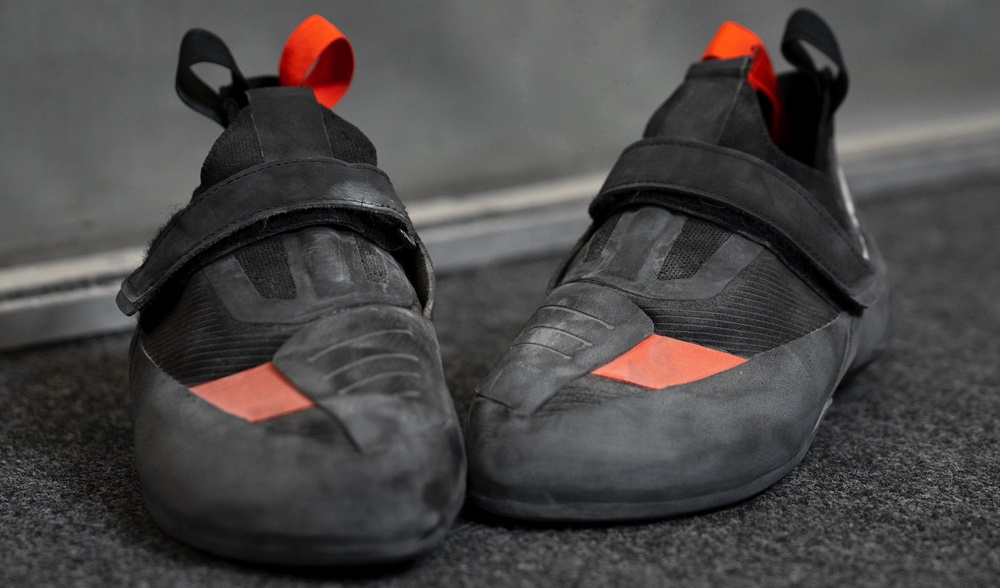As climbers, we’re always searching for that perfect balance between performance and price.
With closeout climbing shoes becoming increasingly popular among budget-conscious climbers, it’s crucial to understand what makes these discounted options worth your hard-earned money.
Whether you’re a beginner looking to upgrade from rental shoes or an experienced climber seeking a backup pair, this comprehensive guide will help you make an informed decision.
Why Consider Closeout Models?
The climbing shoe market has evolved significantly, with annual price increases of 5-15% over the past five years. Let’s look at the average price ranges across different categories:
| Shoe Category | Regular Price Range | Typical Closeout Savings |
| Beginner | $90-120 | 40-50% off |
| Intermediate | $130-160 | 30-60% off |
| Advanced | $170-200+ | 25-70% off |
Key Factors to Consider
1. Age of the Model
The manufacturing date matters more than you might think. Here’s why:
- Rubber compounds can begin degrading after 2-3 years, even in unworn shoes
- Adhesives used in construction may weaken over time
- Newer models often incorporate improved design features and materials
Pro Tip: Look for shoes manufactured within the last 18 months for optimal performance.
2. Storage Conditions
The way closeout shoes have been stored significantly impacts their condition. Pay attention to:
- Temperature exposure (ideal range: 60-75°F)
- Humidity levels (40-60% is optimal)
- Direct sunlight exposure
- Ventilation in storage areas
3. Material Quality Assessment
When evaluating materials, focus on these crucial elements:
- Upper Material Integrity:
- Check for delamination
- Examine stretch potential
- Verify stitching quality
- Assess material flexibility
- Rubber Quality:
- Look for discoloration
- Test tackiness
- Check for hardening
- Examine edge consistency
4. Purpose and Performance Requirements
Consider your climbing style and needs:
| Climbing Style | Critical Features | Acceptable Compromises |
| Bouldering | Heel cup fit, rubber quality | Slightly loose toe box |
| Sport Climbing | Edge precision, comfort | Minor cosmetic flaws |
| Trad Climbing | All-day comfort, durability | Less aggressive shape |
| Gym Climbing | Durability, comfort | Older rubber compound |
Value Assessment Framework
Use this practical framework to evaluate potential purchases:
Calculate the True Value Ratio:
Value Ratio = (Original Price – Closeout Price) / (Expected Lifespan Reduction %)
- Performance Impact Assessment:
- High Impact Issues: Avoid if present
- Delaminating sole
- Compromised rand
- Structural damage
- Moderate Impact Issues: Consider if price is right
- Minor cosmetic flaws
- Slightly aged rubber
- Previous season’s color way
- Long-term Cost Analysis:
| Condition Category | Price Discount | Expected Lifespan | Value Rating |
| Like New | 30-40% off | 95-100% | Excellent |
| Slight Wear | 40-50% off | 80-95% | Good |
| Visible Wear | 50-60% off | 70-80% | Fair |
| Heavy Wear | 60%+ off | <70% | Poor |
Common Pitfalls to Avoid
Don’t let these common mistakes derail your purchase:
- Focusing solely on the discount percentage
- A 70% discount on a compromised shoe isn’t a good deal
- Consider the actual dollar value versus performance trade-off
- Ignoring sizing variations
- Different models and brands size differently
- Account for potential stretch
- Consider temperature effects on fit
- Overlooking return policies
- Some closeout sales are final
- Verify warranty coverage
- Understanding shipping costs for returns
When to Buy and When to Pass
Green Lights 🟢
- Recent models (within 2 years) at 30-50% off
- Minor cosmetic flaws with significant discounts
- End-of-season color variations
- Demo shoes with transparent wear history
- Properly stored warehouse overstock
Red Flags 🔴
- Unknown storage conditions
- Signs of rubber degradation
- Structural compromises
- Models older than 3 years
- Extremely deep discounts without clear reasoning
Tips for Successful Shopping
Make your closeout shopping experience more successful with these proven strategies:
- Research Timing:
- End of season sales (typically March and September)
- Holiday promotional periods
- New model release windows
- Vendor Evaluation:
- Check return policies
- Verify authentication methods
- Read customer reviews
- Assess shipping costs
- Documentation:
- Photograph shoes upon receipt
- Record manufacturing dates
- Save all purchase documentation
- Track performance issues

Investment Analysis
Consider this cost comparison over a one-year period:
| Purchase Type | Initial Cost | Expected Lifespan | Cost per Month |
| Full Price | $180 | 12 months | $15.00 |
| Quality Closeout | $108 | 10 months | $10.80 |
| Budget Closeout | $72 | 6 months | $12.00 |
Making the Final Decision
Ask yourself these critical questions before purchasing:
- Does the discount justify any compromise in performance?
- Will these shoes meet my current climbing needs?
- Is the vendor reputable and do they offer adequate support?
- Have I thoroughly inspected all critical areas of the shoe?
Expert Tips for Maximum Value
Follow these professional insights to get the most from your purchase:
- Timing is crucial: Shop during major retail transitions
- Multiple pairs: Consider buying two pairs if you find an exceptional deal
- Immediate inspection: Check shoes thoroughly upon receipt
- Break-in period: Start break-in process immediately to identify any issues
- Proper care: Implement proper care routines from day one
Maintenance for Longevity
Extend the life of your closeout purchases with these care tips:
- Regular Cleaning:
- Brush after each use
- Deep clean monthly
- Allow proper drying time
- Storage Practices:
- Keep in cool, dry place
- Avoid direct sunlight
- Use breathable bags
- Maintain shape when stored

